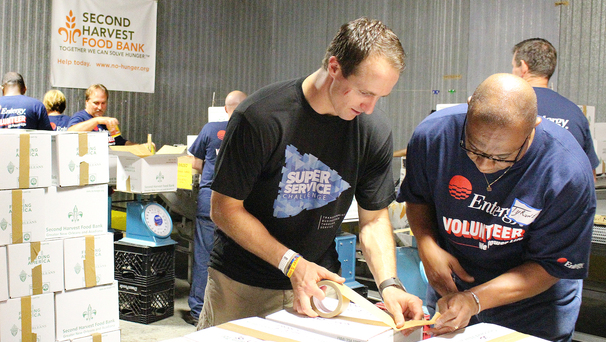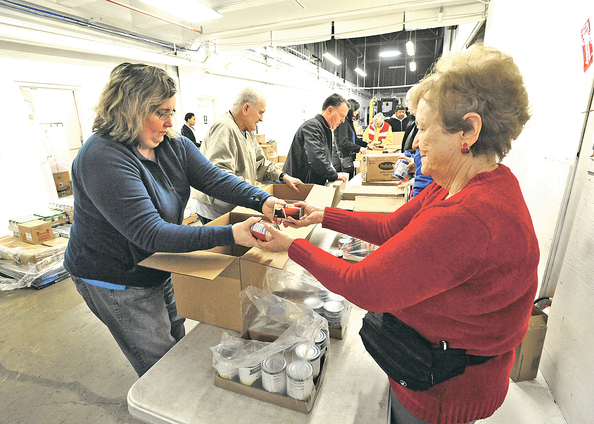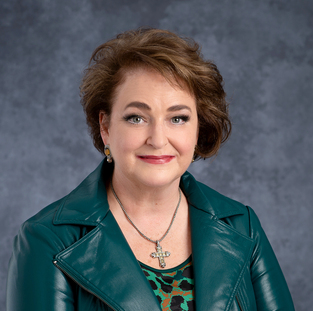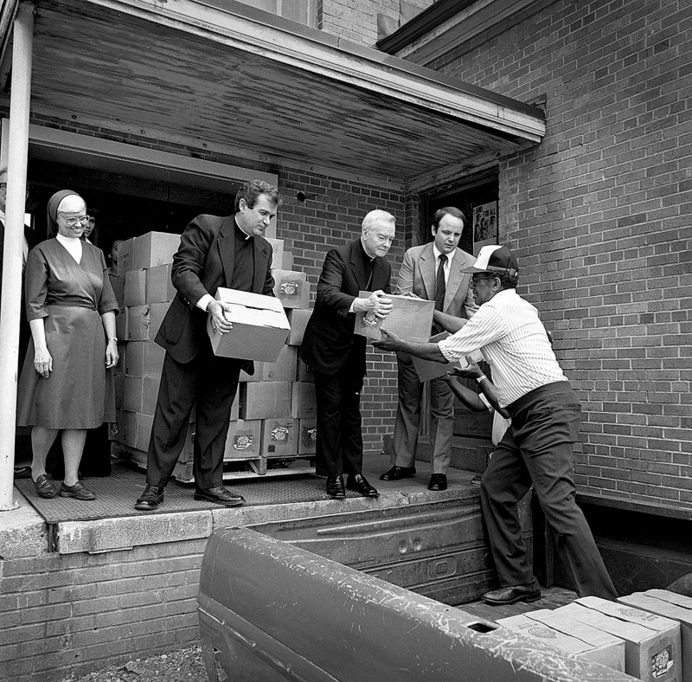
A platform that encourages healthy conversation, spiritual support, growth and fellowship

NOLACatholic Parenting Podcast
A natural progression of our weekly column in the Clarion Herald and blog

The best in Catholic news and inspiration - wherever you are!
Second Harvest: A regional, national game-changer
-

Above: New Orleans Saints quarterback Drew Brees (pictured volunteering at Second Harvest’s Harahan facility in 2014) and his wife Brittany covered start-up funding for the new Second Harvest kitchen in Lafayette, opened last March. (Photo courtesy Second Harvest Food Bank)
Stories by Beth Donze, Clarion Herald
In the movie “It’s a Wonderful Life,” viewers are asked to ponder a compelling question: What would life in the fictional town of Bedford Falls “look like” had George Bailey never been born?With 1 in 5 households in Louisiana at risk for hunger, and with unemployment, low-wage jobs and the rising cost of living leading even formerly food-stable Americans to seek emergency assistance, a related question comes to mind: How much worse would life in Louisiana be were it not for the unflinching presence of Second Harvest Food Bank?
“We think about that all the time, because we know that we are still not providing the 70 million (total annual) meals it would take to make sure everyone in our 23-parish area is food secure,” said Natalie Jayroe, president/CEO of the food bank that serves the southern portion of Louisiana stretching from Texas to Mississippi.
“We provide 35 to 40 million meals a year, so every day we wake up knowing we’re not (completely satisfying the need),” she said. “But at least we’re able to get halfway there. We can provide 35 million meals for families that don’t have other options.”
Primed to serve
Headquartered out of warehouses in Harahan and Lafayette, Second Harvest leads the fight against hunger in south Louisiana by providing nutritious food, advocacy, education and post-disaster support through its more than 700 community partners and programs. Ways in which Second Harvest, a ministry of the Archdiocese of New Orleans, creates pathways out of poverty include:

At left: Volunteers sort donations of food that roll in each day to Second Harvest Food Bank’s warehouse in Harahan. (Photo by Peter Finney Jr., Clarion Herald)
• Year-round provision of perishable and nonperishable food to the food banks of about 300 “pantry partners,” more than half of them faith-based organizations that include 11 Catholic churches. The remainder of Second Harvest’s pantry partners are neighborhood-based non-profits and agencies such as Covenant House.
One less worry for patients
For the last three years, a collaboration with University Medical Center has had Second Harvest stocking an on-site pantry that enables cancer patients to take home fresh, dried and canned foods during their taxing period of treatment. The first hospital-based food pantry in Louisiana, it is a convenient and no-cost option that gets nutritious food to patients who might be struggling with malnutrition, food insecurity or who might not have the time or energy to go to a grocery store or an outside food bank.
• For nearly a decade, Second Harvest has prepared and packaged hot, nourishing meals from its 6,500-square-foot commercial kitchen in Harahan. A second Second Harvest kitchen opened in Lafayette in early March through a generous grant from the Brees Dream Foundation. Seven thousand meals are delivered weekly to after-school programs, senior facilities and other sites, Jayroe said.
“Food banks have traditionally distributed groceries, but if you think about children, seniors and other vulnerable people – they can’t always accept groceries that they can cook themselves,” Jayroe said. “Having a kitchen is a great way for us to serve those who don’t necessarily have the ability to take the bag of rice, the beef, the Blue Runner beans that we give them and turn that into a meal.”
 • Second Harvest partners with the state of Louisiana to teach SNAP (food stamp) recipients in seven rural parishes how to stretch their food dollars and become more resourceful cooks. Its staff, which includes Spanish speakers, also provides assistance to anyone who needs help navigating the SNAP application process. Those who staff Second Harvest’s 300 pantries are also trained to assist food recipients on demand, whether it means assisting them with their SNAP applications or referring them to services Second Harvest does not provide, such as rent and utilities assistance.
• Second Harvest partners with the state of Louisiana to teach SNAP (food stamp) recipients in seven rural parishes how to stretch their food dollars and become more resourceful cooks. Its staff, which includes Spanish speakers, also provides assistance to anyone who needs help navigating the SNAP application process. Those who staff Second Harvest’s 300 pantries are also trained to assist food recipients on demand, whether it means assisting them with their SNAP applications or referring them to services Second Harvest does not provide, such as rent and utilities assistance.• Knowing that principals, teachers and guidance counselors often are the first to detect childhood hunger and malnutrition, Second Harvest stocks food pantries at more than 20 schools throughout its 23-parish service area.
“The principals at the schools will set up an appointment for the families of these children to come in and ‘shop,’” said Jayroe, noting that even schools that initially were hesitant to take on this added responsibility have seen the difference the supplemental food has made on their students’ physical, emotional and academic health.
Another school-based partnership initiated by Second Harvest feeds food-insecure youngsters in St. Charles and St. John the Baptist civil parishes by providing an assortment of “kid-friendly” food they can take home every Friday. The food bags are placed discreetly inside backpacks, as not to draw attention to the recipients,” Jayroe said.
• Each month, Second Harvest’s mobile food pantry makes 60 stops to distribute food in underserved rural areas and in communities where there is limited access to fresh and affordable produce – places commonly referred to as “food deserts.”
“We’ll roll in and distribute the food right off our truck,” Jayroe said, noting that 30 to 40% of the food served from the mobile pantry is donated by area groceries.
For more information, visit www.no-hunger.org. The website guides those in need of food assistance to the Second Harvest partner in their neighborhood.
------------------------------------------------------------------------------------------------------------------------------------------------------------------
Feeding the hungry for nearly 40 years: Second Harvest established under the episcopacy of Archbishop Hannan
The founding of Second Harvest was driven by a seemingly simple mission: creating a win-win relationship between hungry Americans and a food industry that was throwing away millions of pounds of edible food each year, and then getting those provisions to distribution sites such as pantries and soup kitchens.The Second Harvest model was first put into practice in the Catholic Archdiocese of Phoenix in 1967, when 250,000 pounds of surplus foodstuffs were distributed to the hungry at St. Mary’s Food Bank – the first operation of its kind in the world.
Founded by N.O. archdiocese
In 1982, Second Harvest of Greater New Orleans was established under the leadership of Archbishop Philip Hannan, then-Father Roger Morin, Gregory Ben Johnson, director of the Archdiocese of New Orleans’ Social Apostolate, and Daughter of Charity Sister Anthony Barczykowski, then-associate director of Catholic Charities Archdiocese of New Orleans. The new food bank accepted its first donations at Sacred Heart Church on St. Bernard Avenue and set up its first warehouse in 48,000-square-feet of donated space in Jefferson, Louisiana, near the Huey P. Long Bridge. Within a year, the new food bank was funneling food to 23 faith-based and non-profit agencies.
Second Harvest became a fully accredited member of America’s Second Harvest – the nation’s food bank network – in 1985, enabling it to receive large donations from all over the country. A 1989 merger with The Food Bank for Emergencies of Greater New Orleans, Inc., led to the addition of an “Emergency Food Box” program to Second Harvest’s ministry of reclaiming food on the verge of going to waste.
As it grew, the archdiocesan agency went through several name changes, finally becoming Second Harvest Food Bank of Greater New Orleans and Acadiana in 2004. Today, every parish and county in the United States has a food bank it can access through Second Harvest’s 200-member strong “Feeding America” network.
 At left: Leading the charge in the founding of the New Orleans area’s first food bank were, from left, Daughter of Charity Sister Anthony Barczykowski, then-Father Roger Morin, Archbishop Philip Hannan and Gregory Ben Johnson. (File photo by Frank H. Methe III, Clarion Herald)
At left: Leading the charge in the founding of the New Orleans area’s first food bank were, from left, Daughter of Charity Sister Anthony Barczykowski, then-Father Roger Morin, Archbishop Philip Hannan and Gregory Ben Johnson. (File photo by Frank H. Methe III, Clarion Herald)
World’s largest food bankSecond Harvest has made history in other ways.
In 2005, when the double whammy of Hurricanes Katrina and Rita displaced more than a million people from their homes and hundreds of thousands of people found themselves in need of emergency assistance, Second Harvest’s staff regrouped in Baton Rouge and resumed operations just 48 hours after Katrina’s landfall.
By September 2005, Second Harvest had earned the distinction of being the largest food bank in world history, thanks to its collaboration with America’s Second Harvest (now Feeding America) and food bank volunteers from across the country. Initially operating out of a closed Walmart in Baker, Louisiana, and then returning to its facility in Harahan and opening a second facility in Lafayette in 2006, Second Harvest went on to distribute more than 75 million pounds of food during the first two years of post-Katrina recovery.
Today, two ongoing disasters – the COVID-19 pandemic and Hurricane Laura – have put Second Harvest on track this year to provide more than double its usual annual distribution of 35 million pounds of food. Because some of its community partners have temporarily or permanently closed due to the pandemic, Second Harvest has facilitated hundreds of “pop-up” distribution sites at places such as Zephyr Field, Goodwill New Orleans and in collaboration with the city of New Orleans.
Other new distribution sites were organized at Houma’s civic center, various northshore locations and at Lafayette’s Cajun Field.
“In our kitchens, we went from serving 7,000 meals a week to 60,000 meals a week. Our kitchens were up and running 24 hours a day (during the pandemic’s peak),” said Natalie Jayroe, Second Harvest’s president/CEO.
Meets needs head-on
From the time another disaster – Hurricane Laura – made landfall in late August, Second Harvest has put nearly 2 million pounds of food and other supplies into the hands of impacted residents, Jayroe said. The food bank, in coordination with Catholic Charities of Southwest Louisiana, has established new relationships and distribution sites at area firehouses, the Coushatta Tribe reservation in Allen Parish, grocery store parking lots and other community hubs across the battered region. Second Harvest also has been delivering daily hot meals and non-perishable food to coastal communities, Jayroe said.
“There is going to be a long period of recovery,” Jayroe said. “For us (at Second Harvest), the ‘disaster’ lasts as long as people are unemployed; or children aren't going to school and not getting the breakfast and lunch that they normally get; or seniors aren’t able to go to grocery stores. We are here as the community puts itself back together. Unfortunately, we have a lot of job security.”
For more information, visit www.no-hunger.org. The website also can point those in need of food assistance to the Second Harvest partner in their neighborhood.




